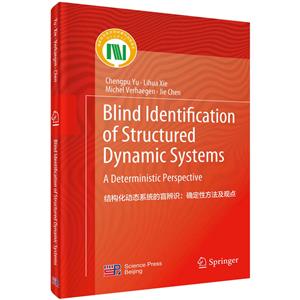中圖網小程序
一鍵登錄
更方便
本類五星書更多>
-
>
宇宙、量子和人類心靈
-
>
氣候文明史
-
>
南極100天
-
>
考研數學專題練1200題
-
>
希格斯:“上帝粒子”的發明與發現
-
>
神農架疊層石:10多億年前遠古海洋微生物建造的大堡礁
-
>
聲音簡史
結構化動態系統的盲辨識:確定性方法及觀點(英文版) 版權信息
- ISBN:9787030781710
- 條形碼:9787030781710 ; 978-7-03-078171-0
- 裝幀:精裝
- 冊數:暫無
- 重量:暫無
- 所屬分類:>
結構化動態系統的盲辨識:確定性方法及觀點(英文版) 內容簡介
本書全面且深入地研究盲系統辨識問題,通過利用系統模型的結構特性,提供確定性辨識解決方案,以揭示相關數值計算的基本代數性質。基于子空間的辨識方法是處理傳統盲辨識問題和經典狀態空間辨識問題的一種常用方法,它將被廣泛應用和推廣,以解決若干具有挑戰性的結構化系統盲辨識問題。從很優化的角度看,子空間辨識技術可以看做是求解低秩矩陣分解或低秩極小化問題的方法,但它不能處理具有結構約束的動態系統的盲辨識問題。針對這一問題,提出了一種差分凸規劃方法,該方法比傳統的基于梯度的優化方法能得到更可靠的辨識結果。總之,本書旨在為處理具有挑戰性的系統事變問題提供獨到深刻的求解思路/見解。
結構化動態系統的盲辨識:確定性方法及觀點(英文版) 目錄
Contents1 Introduction 11.1 Examples of the Blind System Identification 11.2 Optimization Based Blind System Identification 41.3 Blind Identification of Various System Models 51.4 Organization of This Book 6References 8Part I Preliminaries2 Linear Algebra and Polynomial Matrices 112.1 Vector Space and Basis 112.2 Eigenvalue Decomposition 132.3 Singular Value Decomposition 152.4 Orthogonal Projection and Oblique Projection 162.5 Sum and Intersection of Subspaces 182.6 Angles Between Subspaces 192.7 Polynomial Matrices and Polynomial Bases 202.8 Summary 24References 243 Representation of Linear System Models 253.1 Transfer Functions 253.1.1 Properties of Coprime Matrix Fraction 263.1.2 Verification and Computation of Coprime Matrix Fraction 283.2 State Space Models 313.3 State Space Realization 383.4 HankelMatrix Interpretation 403.5 Structured State-Space Models 413.5.1 Graph Theory 423.5.2 Structured Algebraic System Theory 443.6 Summary 47Reference 484 Identification of LTI Systems 494.1 Least-Squares Identification 504.1.1 Identifiability of a Rational Transfer Function Matrix 504.1.2 Least-Squares Identification Method 514.2 Subspace Identification 534.2.1 Subspace Identification via Orthogonal Projection 554.2.2 Subspace Identification via State Estimation 564.2.3 Subspace Identification via State Compensation 594.2.4 Subspace Identification via Markov Parameter Estimation 614.3 Parameterized State-Space Identification 624.3.1 Gradient-BasedMethod 634.3.2 Difference-of-Convex Programming Method 644.4 Summary 69References 70Part II Blind System Identification with a Single Unknown Input5 Blind Identification of SIMO FIR Systems 735.1 Structured Subspace Factorization 745.1.1 Blind Identification of FIR Filters 755.1.2 Blind Identification of a Source Signal 785.2 Cross RelationMethod 805.3 Least-Squares Smoothing Method 835.3.1 Blind FIR Filter Identification 845.3.2 Blind Source Signal Estimation 855.4 Blind Identification of Time-Varying FIR Systems 865.4.1 Input Signal Estimation 875.4.2 Time-Varying Filter Identification 885.5 Blind Identification of Nonlinear SIMO Systems 905.5.1 SIMO-Wiener System Identification 915.5.2 Hammerstein-Wiener System Identification 935.6 Summary 94References 956 Blind Identification of SISO IIR Systems via Oversampling 976.1 Oversampling of FIR and IIR Systems 986.1.1 Multirate Identities 986.1.2 Multirate Transfer Functions 996.1.3 Multirate State-Space Models 1036.2 Coprime Conditions for Lifted SIMO Systems 1046.3 Blind Identification of Non-minimum Phase Systems 1086.4 Blind Identification of Hammerstein Systems 1106.4.1 Blind Identifiability 1116.4.2 Blind Identification Approach 1126.5 Blind Identification of Output Switching Systems 1146.6 Summary 125References 1267 Distributed Blind Identification of Networked FIR Systems 1277.1 Motivation for the Distributed Blind Identification 1277.2 Distributed Blind System Identification Using Noise-Free Data 1287.2.1 Distributed Blind Identification Algorithm 1297.2.2 Convergence Analysis 1317.2.3 Numerical Simulation 1367.3 Distributed Blind System Identification Using Noisy Data 1387.3.1 Distributed Blind Identification Algorithm 1397.3.2 Convergence Analysis 1407.3.3 Numerical Simulation 1477.4 Recursive Blind Source Equalization Using Noisy Data 1487.4.1 Direct Distributed Equalization 1497.4.2 Indirect Distributed Equalization 1517.4.3 Distributed Blind Equalization with Noise-Free Measurements 1527.4.4 Distributed Blind Equalization with Noisy Measurements 1567.4.5 Blind Equalization with a Time-Varying Topology 1577.4.6 Numerical Simulation 1597.5 Summary 162References 163Part III Blind System Identification with Multiple Unknown Inputs8 Blind Identification of MIMO Systems 1678.1 Blind Identification ofMIMO FIR Systems 1678.1.1 Identifiability Analysis 1698.1.2 Subspace Blind Identification Method 1718.2 Blind Identification of Multivariable State-Space Models 1738.2.1 Identifiability of Two Channel Systems 1748.2.2 Blind Identification of Characteristic Polynomials 1798.2.3 Blind Identification of Numerator Polynomial Matrices 1838.2.4 Numerical Simulation 1928.3 Summary 197References 1989 Blind Identification of Structured State-Space Models 1999.1 Strong Observability of Structured State-Space Models 1999.1.1 Maximum Unobservable Subspace 2009.1.2 State Estimation with Unknown Inputs 2029.2 Blind Identification of Multivariable State-Space Models 2049.2.1 Identifiability Analysis 2069.2.2 Subspace-Based Blind Identification Method 2159.2.3 Numerical Simulations 2209.3
展開全部
書友推薦
- >
月亮與六便士
- >
苦雨齋序跋文-周作人自編集
- >
山海經
- >
隨園食單
- >
經典常談
- >
李白與唐代文化
- >
莉莉和章魚
- >
姑媽的寶刀
本類暢銷















